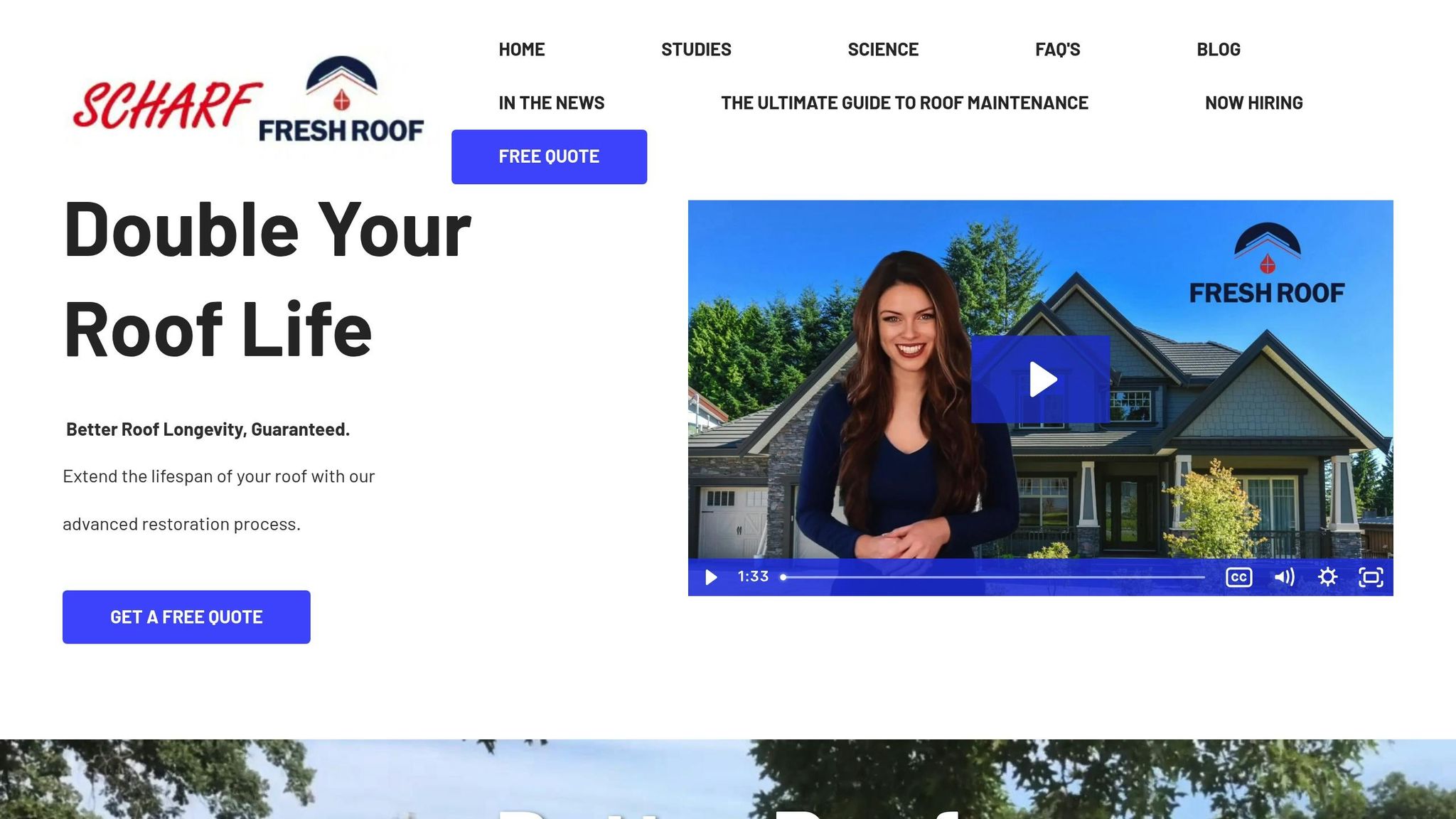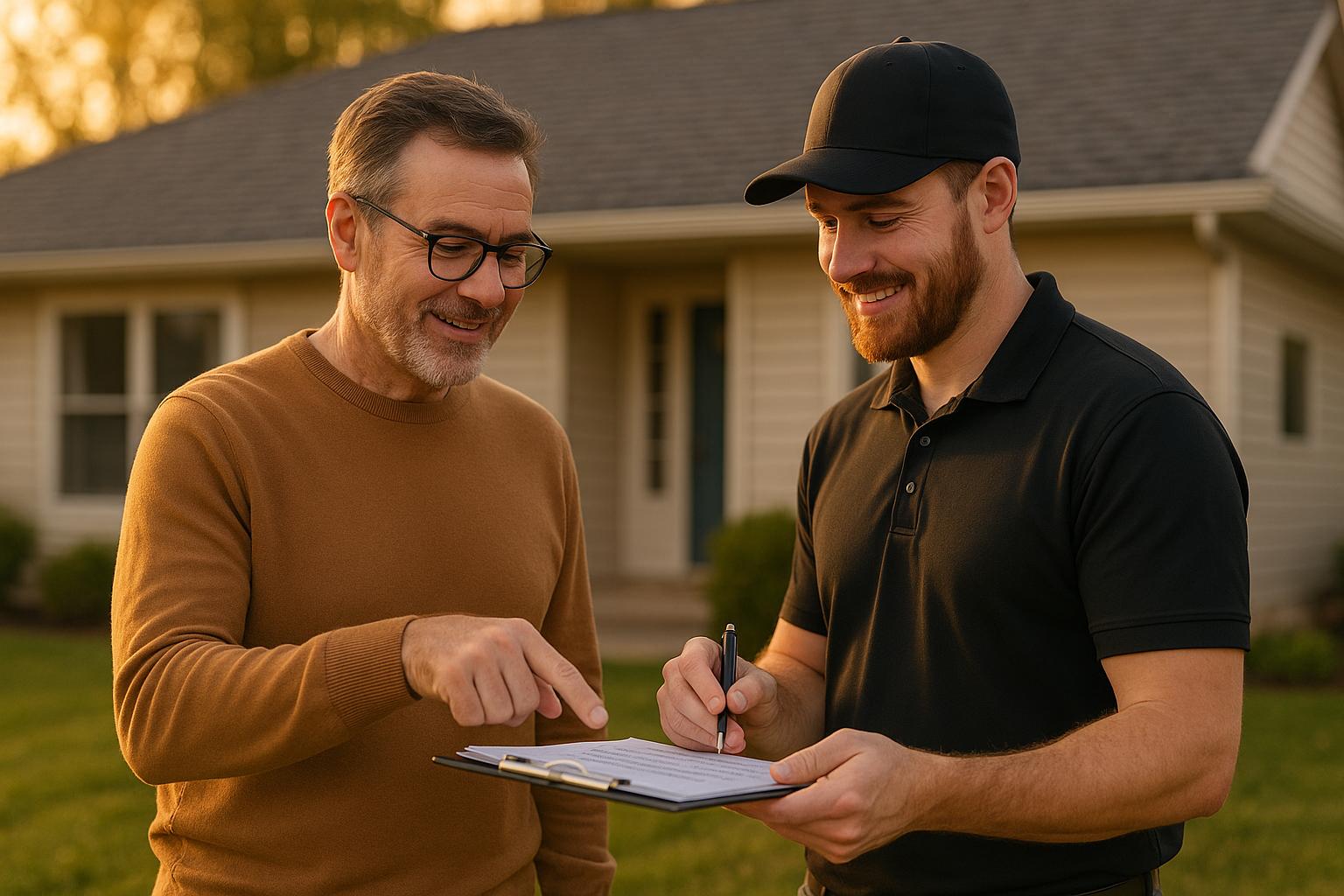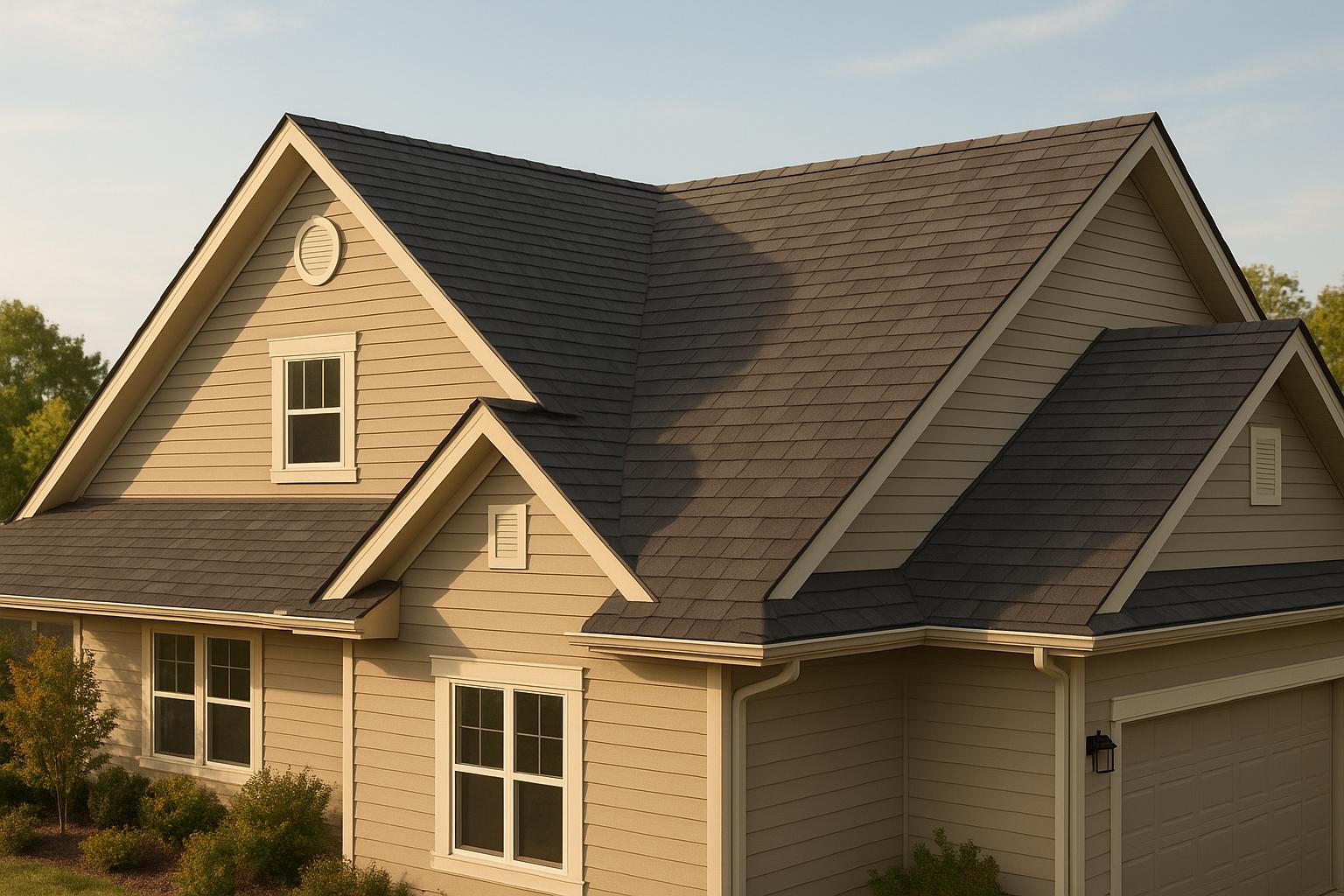Roof rejuvenation treatments can extend the lifespan of asphalt shingle roofs by 5 to 15 years. This process restores lost oils in shingles, improving flexibility, durability, and resistance to weather damage. Research shows that roofs aged 8 to 12 years respond best, while regular maintenance like inspections and reapplications ensures long-term effectiveness. Compared to full roof replacement, rejuvenation is a cost-effective option ($500–$2,000 vs. $8,000–$20,000) and reduces landfill waste by preserving existing materials. For homeowners, it offers a practical way to protect their investment while saving money and time.
Roof Renewal extends the life of your roof by 5 to 15 years
Study Results: How Rejuvenation Affects Roof Lifespan
Research confirms that rejuvenation treatments can extend the life of asphalt shingle roofs, offering homeowners a practical and less expensive alternative to full roof replacement. These findings provide clear evidence of the benefits of rejuvenation.
How Much Longer Roofs Last After Rejuvenation
Studies reveal that roof rejuvenation can add an extra 5 to 15 years to the lifespan of asphalt shingle roofs. This is especially important since roofs often show significant wear and tear after about 10 years.
Asphalt shingles naturally lose the oils that keep them flexible over time. This loss makes shingles brittle, causing granule shedding and increasing their vulnerability to cracking, wind damage, and storm impact.
"This rejuvenation process works by penetrating deep into the shingle structure, replenishing the petrochemical oils that allow shingles to expand and contract with temperature changes." - Roof Rejuvenate USA
Research from Applied Research Associates (ARA) found that nearly half of all shingle roofs inspected showed noticeable deterioration after just 10 years. This challenges the widespread belief that asphalt shingles remain durable for 20-30 years and highlights the value of rejuvenation in restoring performance before costly replacement becomes necessary.
What Affects How Well Rejuvenation Works
The success of rejuvenation treatments depends on several factors. Roofs between 8 and 12 years old tend to respond best, as their shingles still have enough structural integrity to benefit from replenished oils.
Climate conditions also play a big role. Roofs in areas with harsh weather - like extreme temperature swings, high UV exposure, or frequent storms - may need more frequent treatments to maintain their performance. Additionally, the type of roof material and the specific formulation of the rejuvenation product can influence results.
How Roof Performance Improves After Treatment
Rejuvenation treatments not only slow down the aging process but also improve the overall performance of roofs. For example, an Ohio State University study on 17-year-old shingles treated with Roof Maxx highlighted several improvements compared to untreated shingles.
Treated shingles showed greater flexibility, which boosts durability and resistance to wind damage. This increased flexibility helps shingles endure temperature changes and physical stress without cracking.
Granule adhesion improved significantly, with treated shingles appearing closer to their original condition. Stronger granule adhesion ensures that roofs retain their protective layer against UV rays and weather-related damage.
"By spraying our treatment onto asphalt shingles, we can help restore their flexibility and prevent them from cracking." - Roof Maxx
The study also documented a 24% reduction in hail damage for treated shingles. This enhanced impact resistance provides better protection for homes during severe storms.
Another key finding: rejuvenation treatments do not increase fire risks. Treated shingles maintain their fire-resistant properties while gaining improved durability and weatherproofing. Enhanced waterproofing is another major benefit, as rejuvenated shingles are better at resisting moisture, reducing the likelihood of leaks and water damage to the roof and interior of the home.
How Maintenance Keeps Rejuvenation Benefits Working
Rejuvenation treatments can extend a roof's lifespan, but they work best when combined with consistent maintenance. These treatments restore the oils that keep shingles flexible, but environmental factors - like weather and debris - continue to impact the roof daily. Regular inspections and upkeep are key to ensuring the treatment's effectiveness and longevity.
Regular Inspections and Preventive Care
Routine inspections are essential for spotting potential issues early and maintaining the benefits of rejuvenation. Focus on areas prone to wear, such as edges, valleys, and spots around vents or chimneys. These are the zones most likely to show signs of stress.
During an inspection, check that shingles remain flexible and that granules are still firmly attached. Clean gutters regularly to prevent water buildup, which can compromise even a treated roof. Trimming overhanging branches also helps by reducing the risk of physical damage and limiting debris accumulation. These simple steps protect your investment and slow down wear caused by external factors.
Keep an eye on granule loss. While some shedding is normal, excessive loss or shingles starting to curl or feel brittle may indicate the need for maintenance or reapplication. Regular inspections ensure that any necessary touch-ups or treatments are done on time.
When to Reapply Treatments and Do Touch-Ups
Inspection results often dictate when reapplication or touch-ups are needed. If shingles lose the flexibility restored by the treatment or show increased granule loss, it might be time for another round of care.
Local climate plays a big role in determining timing. Roofs in areas with extreme temperature changes, high UV exposure, or harsh weather may require more frequent treatments. Conversely, roofs in milder climates might hold up longer before needing additional attention.
For localized issues, consider targeted touch-ups instead of treating the entire roof. Areas under heavy sunlight or stress often need extra care. A professional assessment can help determine whether the rejuvenation is still effective or if certain spots require immediate attention.
Think of rejuvenation as part of an ongoing maintenance plan. Regular care not only extends the roof's lifespan but also reinforces the benefits of rejuvenation, ensuring your roof stays in great shape for years to come.
sbb-itb-b7819d6
Cost Savings and Environmental Benefits of Roof Rejuvenation
Roof rejuvenation not only extends the life of your roof but also helps save money and reduces waste.
How Rejuvenation Helps the Environment
Roof rejuvenation is an environmentally friendly alternative to full roof replacement. By restoring your existing roof instead of replacing it, rejuvenation significantly reduces the amount of waste sent to landfills.
The process itself is resource-efficient. Unlike a full replacement - which involves new shingles, underlayment, flashing, and other materials - rejuvenation uses specialized treatments to restore the flexibility and oils in your current shingles. This approach cuts down on the environmental impact associated with manufacturing and transporting new materials.
Scharf Fresh Roof takes these benefits further with its patented GreenSoy Technology, which uses plant-based formulations for treatments. Beyond that, they plant a tree for every roof they treat, creating a long-term positive impact on the environment.
Producing new shingles consumes considerable energy and raw materials. By extending the life of your roof through rejuvenation, you help conserve natural resources and reduce emissions tied to manufacturing. The environmental benefits are clear - and they come with the added bonus of cutting costs.
Money Homeowners Save with Rejuvenation
Roof rejuvenation is a cost-effective solution. For most homeowners, it costs between $500 and $2,000, compared to the $8,000–$20,000 price tag of a full replacement. These savings are paired with the benefit of extending your roof's lifespan, which reduces the need for costly repairs or premature replacements.
Time is another area where rejuvenation shines. While a roof replacement can take days or even weeks, rejuvenation is typically completed in just 1–3 hours. This means less disruption to your daily life and fewer hidden costs that often come with lengthy projects.
Rejuvenation also allows for better financial planning. Instead of facing a large expense every 15–20 years, homeowners can opt for periodic treatments that extend the roof's life by up to 5 years per treatment. In some cases, treatments can add 6 to 18+ years to a roof's lifespan. This approach spreads out costs over time and reduces the financial strain of an emergency replacement.
"Fresh Roof treatment costs 90% less than roof replacement, making it an excellent choice for homeowners who want to maximize their roof's life without the hefty price tag."
Maintaining your roof also boosts your home's value. Scharf Fresh Roof offers a transferable warranty, which can be a selling point when it’s time to move. This warranty underscores the quality of the rejuvenation process and protects your investment.
Full roof replacements often come with hidden costs, like temporary relocation or extended project timelines. Rejuvenation avoids these issues entirely, offering a hassle-free alternative.
For those managing tight budgets, roof rejuvenation provides flexibility. Treatments can be scheduled based on your financial situation, giving you control over timing and helping you avoid the stress of unexpected major expenses.
Conclusion: Getting the Most from Roof Rejuvenation
Extending the life of asphalt shingles is possible with roof rejuvenation, especially when combined with regular maintenance. By understanding how this treatment works and making it part of your overall roof care plan, homeowners can enjoy longer-lasting protection for their roofs.
What Homeowners Should Know
Roof rejuvenation helps restore the flexibility of shingles and strengthens their resistance to wind and hail. To get the most out of this treatment, it’s important to apply it while the roof is still in good condition. Pairing this with routine maintenance not only extends the benefits but also helps manage repair costs down the line. Plus, choosing rejuvenation over replacement is a smarter, eco-friendly option that cuts down on waste.
These strategies can help homeowners make informed decisions and get expert support for their roof care needs.
How Scharf Fresh Roof Supports Roof Rejuvenation

Scharf Fresh Roof uses its patented GreenSoy Technology to bring asphalt shingles back to life, improving their flexibility and durability. This treatment boosts resistance to wind and hail while keeping the roof’s structure intact.
Scharf Fresh Roof also offers transferable warranties, which can protect your investment and even add appeal if you decide to sell your home. On top of that, the company plants a tree for every treated roof, making it a sustainable choice for maintaining your home.
FAQs
How can I tell if my roof is suitable for a rejuvenation treatment?
To figure out if your roof is a good fit for rejuvenation, you’ll want to look at three key factors: its age, overall condition, and signs of wear and tear. Roofs that are between 12 and 18 years old, have retained at least 75% of their granules, and show minor signs of aging - like slight curling, fading, or minimal granule loss - are usually great candidates for this treatment.
On the other hand, if your roof has serious structural issues, significant granule loss, or is nearing the end of its lifespan, rejuvenation might not be the best solution. Staying on top of regular maintenance and scheduling timely inspections can help keep your roof in the right shape for rejuvenation and allow you to get the most out of treatments like those provided by Scharf Fresh Roof.
How often should I reapply roof rejuvenation treatments, especially in areas with extreme weather?
Roof rejuvenation treatments generally remain effective for about five years, making it wise to schedule reapplications every five years to maintain protection and performance. If you live in a region prone to extreme weather - like heavy storms, strong winds, or scorching heat - regular roof inspections and potentially more frequent treatments might be necessary to keep your roof in top shape.
By staying on top of maintenance and reapplying treatments as needed, a rejuvenated roof can last 15 years or more. This approach can save homeowners a considerable amount of money compared to the cost of a full roof replacement. Taking a proactive approach ensures your roof remains durable and performs well over the years.
How does roof rejuvenation benefit the environment compared to replacing the entire roof?
Roof rejuvenation offers a greener option compared to a full roof replacement. By restoring your current roof, you cut down on waste heading to landfills and save the natural resources typically required to produce new materials. Plus, this approach trims the energy use and carbon emissions tied to manufacturing and transporting new roofing products.
Another bonus? Roof rejuvenation extends the lifespan of your roof, meaning fewer replacements in the long run. This not only reduces waste but also lessens the overall environmental impact. It's a smart, eco-conscious way to care for your home and reduce your carbon footprint.

